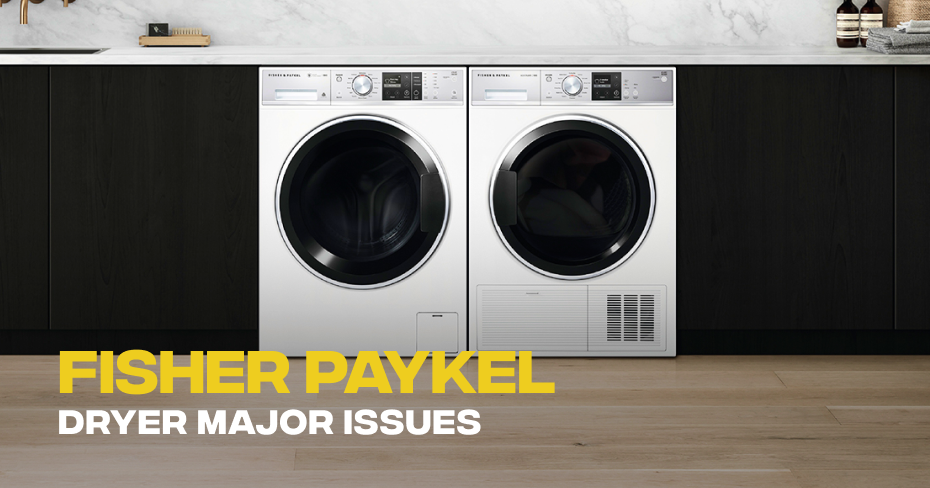
Fisher Paykel Dryer Overheating
Why is a dryer overheating badly? When a dryer gets too hot, it can burn your hands, damage your laundry, or cause a fire. It can also damage the inner workings of the dryer, causing short circuits or burns inside the control system. What causes a dryer to overheat? Here’s the rundown of the most common problems resulting from dryer overheating.
Reason #1. Dust and dirt getting into the air hole
If the air filter inside the dryer is dusty or dirty, it’s harder for the appliance to heat the air. As a result, the device uses more energy to create enough heat. After a short while of use, a dryer with a clogged filter will start overheating and shut off on its own. To make sure you are taking good care of the dryer, clean the appliance after every two or three uses.
Reason #2. Airflow restrictions
If the air gets stuck inside a dryer’s internal duct instead of coming out, you will likely get the dryer overheated. It’s worth checking the power of the airflow from the duct inside the dryer to ensure it’s not clogged or rusty. Since using an old air duct increases the risk of fire hazards, replace it to prolong the device’s lifespan and stay safe.
Reason #3. Heating element issues
When a device is new, the heating element responds well to temperature changes, increasing the warm air output as you switch the temperature mode. However, as the device ages, the heating element can shift and suffer micro burns or circuit shortages. It can then heat too slowly or too quickly. A dryer commonly overheats because the heating elements have shifted and are now touching other appliance parts directly. Call a technician to adjust the position of the component. If the heating element is broken or damaged, you can replace it.
Reason #4. The cycling thermostat doesn’t activate
A cycling thermostat is a device’s way to protect itself from overheating. Once a dryer gets too hot, this component reacts to the increased temperature and shuts the appliance off automatically. However, if a cycling thermostat isn’t functioning, it may be why a clothing dryer is overheating and shuts off. To access, repair, or replace the thermostat, you must remove the dryer’s back panel. Once you have the full view of the component, do some testing using a multi-probe device. If the reading is ‘zero,’ the thermostat works. If it’s infinity, you will have to replace it. The good news is thermostats are relatively inexpensive — getting a new one is cheaper than replacing the dryer.
How to Prevent a Dryer from Overheating
The best way to prolong the appliance’s lifespan, ensure safe use, and avoid calling a technician is by following good maintenance practices. Here are some tips you can use for troubleshooting when your dryer gets too hot and shuts off.
Tip #1. Control dryer settings
The rule of thumb is that the dryer temperature selector shouldn’t go above “medium.” Using high-mode heating increases the heat damage to your clothes and may cause circuit burns and other mechanical issues. If you don’t have many heating options, choose the temperature setting that doesn’t feel too hot when you put the palm of your hand next to the stream of air from the dryer.
Tip #2. Clean the drum of the dryer thoroughly
Depending on the frequency of use, you should clean your appliance every couple of uses. Otherwise, you will see the dryer overheating and shutting off. Make sure the device is unplugged before you start cleaning. Instead, don’t use anything wet; instead, choose dry cotton pads, a clean makeup sponge, or a sock. To clean the device’s exterior, mix equal parts vinegar and warm water.
Tip #3. Don’t overuse the dryer
Try not to use the dryer for more than 40-50 minutes at one time. Although the overall lifespan of some models can go up to 1,500, don’t let the number trick you. It’s easy to overheat the coil and damage the inner circuits of the system if you keep the dryer on for an extended period. Don’t use a dryer as a household heater, either. Since it was not designed for the purpose, you could increase the risks of fire hazards. Keep a timer nearby to track how long the appliance is running.
Tip #4. Clean the lint screens
Lint screens are one of the dryer components ensuring the safety of usage. For one, they capture lint, grease, and dust, ensuring nothing gets stuck inside the heating coil. Once a screen has stopped letting air through, an appliance can overheat. By keeping these screens clear, you improve the appliance’s energy efficiency, protect your clothes from heat damage, and minimize fire risks. To clean the dryer lint protection screens, remove the protective cover with a snapping or twisting motion. If the protection screen is hardened by dust and dirt, moisten the Q-tip or a sponge, making sure no water is dripping from it. Rotate the Q-tip or sponge across each screen area to remove the dust and dirt.
Tip #5. Make sure the dryer cord doesn’t knot
One reason dryers overheat is that the cord that connects the appliance to the outlet has become knotted. Take some time to untie the knots until the cord makes a perfectly straight line. Plug the dryer back in and evaluate its performance.
Schedule Appointment